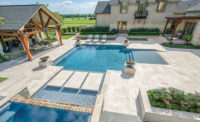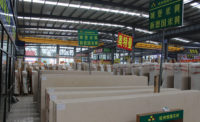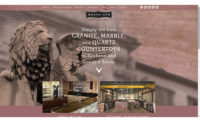Boasting a population of over 850,000 people, Gurgaon, India, is located in the national capital region of India. Located 20 miles southwest of New Delhi, Gurgaon has become a leading financial and industrial hub with the third highest per capita income in India. In 1999, DLF Golf and Country Club opened its doors and became the first Arnold Palmer Signature course in the country. The course was also the first to offer night golf and the first professional golf academy in the country. Since its opening, the course has held the Johnnie Walker Classic, Asia’s premier event. Six editions of the Women’s Indian Open, three editions of the Avantha Masters and the Indian Open have all been held at the course.
Last spring, the golf course went under a series of improvements that included a new reception plaza, golf shop and golf pavilion. The design was envisioned to include extensive amounts of stone as a natural material that fits with the beautiful landscape, conveying the image of legacy and luxury. Jeff Fossum, AIA, principal and general manager for Z Design Group, based in Boulder, CO, was the architect who worked on the project. “This is the largest real estate developer in India and they saw this as their flagship project,” said Fossum. “While they completed it last year, they have been working on it for quite a while -- getting approvals and design changes. They were working to get it just the way they wanted it. They probably started the project about eight years ago or so, but just recently got really serious about the new clubhouse facility.”
Fossum collaborated with a local architect on the project. “The client had a very specific vision of what he wanted,” said Fossum. “At first there was some head scratching on how to blend the very traditional style of the two buildings that fit in with the existing facilities and the third building that does not have, just as far as exterior architecture goes, anything to do with the other buildings. The interiors like the locker rooms would blend more with the traditional facilities. They blend much better, but at the restaurant level they are much different.”
The concept for the clubhouse was to design it as an open pavilion, to help create a club experience unlike any other in India and beyond. The project was envisioned to blend the new facilities with the classic-traditional style of the original facilities, while integrating a fresh experience for this new hub of the club’s activities. The reception plaza and golf shop buildings serve as portal entries from the autocourt. The golf pavilion, conceived to be an open-sided structure at the crown of a hill, overlooks the course designed by Gary Player. The golf pavilion is 19,375 square feet, the golf pro shop is 2,045 square feet and the reception hall is 2,755 square feet.
For the design, rough faced stone blends with the surrounding natural environment, harmoniously combined with polished stone materials that evoke classic and traditional heritage. “The pavilion concept really came from the client that envisioned it,” said Fossum. “We all came together and worked together. The local architect was focused more on the exterior shape of the building while we were more responsible for the selection of the materials, and we did all the interior layouts and space planning for the facilities.”
The rough-faced wall cladding used for the project is Teak sandstone from special quarries in Rajasthan, located in the western region of India. Floors in the golf pavilion are also Teak sandstone, except honed to a smooth surface and a random pattern with tight joints. The restrooms, shower and spa areas include polished slabs of Spanish marble – Crema Marfil and Light Emperador. At entry to the golf pavilion is a polished black granite
fountain. Granite paving and cobbles are used extensively, as well as in the outdoor areas. The split-face wall cladding is used in a random ashlar pattern with thickness of 4 to 6 inches. Polished marble slabs used for floors and walls are up to 63 inches in size.
While the construction as a whole took approximately 12 months, near the end it became a 24/7 project. “It was a blitz of people at the end,” said Fossum. “They had 600 people working on it 24 hours a day the last few weeks. The client set that deadline, and they had enormous crews working on it at the end.”
One of the challenges came with the stone masons in Indian. While they were skilled craftsmen, it could be a challenge sometimes to achieve the appearances the architects envisioned from their U.S. perspective, using construction materials, means and methods that are utilized in India. “We had an idea of certain joint patterns that we wanted and when it was outside of what they were accustomed of doing, there were challenges there,” said Fossum. “We just had to work with them for a bit longer and really try to explain what we were looking for. It took time, but we worked through it and everybody ended up proud in the end.”
For Z Design Group, this is a very unique project. The company has done quite a few golf clubhouses, but the uniqueness of this project was the separate buildings. Also, surrounding the clubhouse are high-rise condominiums and the golf course and clubhouse were put at the center of it all. The client’s representatives have told Z Design Group since its completions that, “The overall reaction of the club members has been very overwhelming. They are extremely happy with the world-class facility. Members have all agreed that they have not experienced something like this in India. It is one of a kind.”








